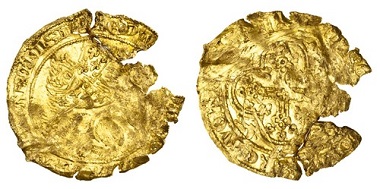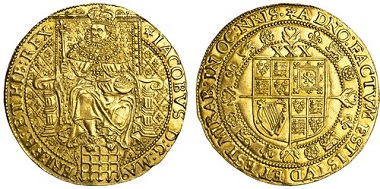25-09-2016 – 01-01-1970
Auction 16021: The Academic Collection of Lord Stewartby, Part 3
Leopards can’t change their spots, but England can change its coinage
On the 26th September 2016, Spink’s London auction room will see the third instalment, 152 lots made up of the most astonishing gold coins (and even a leopard) from between the reigns of Edward III and George III.
Spink are pleased to announce the perfect accompaniment to the golden sunshine; a gold coin auction! Earlier in the year Spink had the pleasure of selling parts 1 and 2 of Lord Stewartby’s vast collection, and the time has come to sell the third. The collection, being offered across five sales, is one of the most extensive and important collections of English coins to come on the market in recent times and the catalogues alone will become works of reference in their own right.
For those unfamiliar with Lord Stewartby’s career as a coin collector, he is Honorary Keeper of Mediaeval Coins at the Fitzwilliam Museum, Cambridge and developed an early interest in coin collecting. His passion was sparked when in the ill-lit streets of war-torn Barnet, Ian Stewart, as he was then, noticed a copper coin in a jar on the counter of a grocer’s shop with two heads on it and recognised it as being from the reign of William & Mary. And thus began his lifelong interest in, and contribution to, numismatics.
Lot 893: Edward III (1327-77), Leopard or Florin, N.1106; S.1477; Schneider -; Stewartby p. 196. A ‘found’ example – scraped, broken and repaired otherwise fair, with some clear detail, a denomination of the greatest historical importance, very few known. Estimate: £4,000-5,000.
The very first lot in this sale is the much-anticipated Edward III Leopard of Florin (third coinage, first period) with the iconic crowned leopard walking left, bearing banner with the arms of England and France on the obverse.
A denomination of the greatest historical importance, only four examples of the leopard survived (all from different pairs of dies). What is most curious however, is that nearly five hundred years elapsed between the time when these coins were in circulation and the date when an example was actually seen by an antiquary, and that during all this period the proclamation and indenture relating to their striking and currency were extant.
The Proclamation authorising the currency of the Florin and its parts has been known for four centuries and is still extant. It is in Norman French, and is given by Sir John Evans in ‘The First Gold Coins of England’ Numismatic Chronicle, Third Series, Vol. XX pp. 218-251 (1900):
‘The King to the Sheriffs of London, Greeting . . . for the common profit of our people of the said kingdom that three coins of gold be made in our Tower of London, that is to say: One coin of two Leopards, the piece current for six shillings, which shall be of the weight of two small florins of Florence of good weight; and one coin of gold of one Leopard, weighing the half of the other aforesaid coin, the piece current for three shillings. And one coin of gold of a Helmet, weighing the fourth part of the aforesaid first coin, the piece current for eighteen pence. The which coins of gold ought to have course among all manner of persons within the said realm of England . . . and that every man of whatever condition, private or stranger, shall receive the said coins of gold in every manner of payment, and likewise that the coins be refused of none under evident peril and herein fail in no manner. Given at Westminster on the 27th day of January.’ (1344, or 1343 O.S.)
Lord Stewartby notes ‘The designs of the three new denominations introduced in January 1344 are among the most attractive of any in the whole of the English coinage. They can fairly stand comparison with the magnificent gold coins of France and Flanders at this high point in the flowering of Gothic art. The leopard is a splendid coin. On the epitaph in Westminster Abbey Edward III is described as invictus pardus, and the lion, known heraldically as a leopard, was already a powerful symbol of the English crown’.
Lot 1018: James I (1603-25), Rose-Ryal, N.2108; S.2632; Schneider 77 same dies. Almost extremely fine, very rare. Estimate: £15,000-20,000.
Spink do not always believe in saving the best till last, but in this case there is a fantastic item, the star of the show even, towards the end of the sale: Lot 1018, a James I (1603 – 25) Rosa-Ryal of the third coinage bearing a fantastically sharp image of the king seated on throne holding orb and sceptre. It is a handsome example, almost extremely fine and very rare in this condition.
Lord Stewartby has written extensively on the subject for more than fifty years. As is well-known, his first love was, and remains, the coinage of Scotland up to the reign of Charles II and his first book, The Scottish Coinage, was published in 1955. This was revised in 1967 and is currently under further revision. In 2009, after some twelve years in writing, he published English Coins 1180-1551, which was described by one reviewer as ‘nothing short of a masterpiece’ and is available from Spink.
Please find the entire online auction catalogue here.
Further details of forthcoming auctions can be found on the firms website. For more information about the sale or book enquiries, please contact Phil Skingley. The book is published and sold by Spink.





